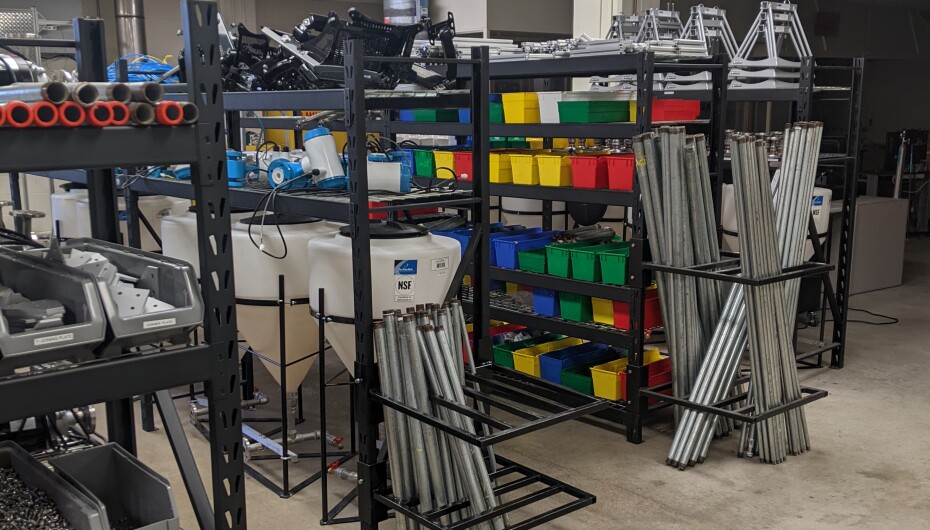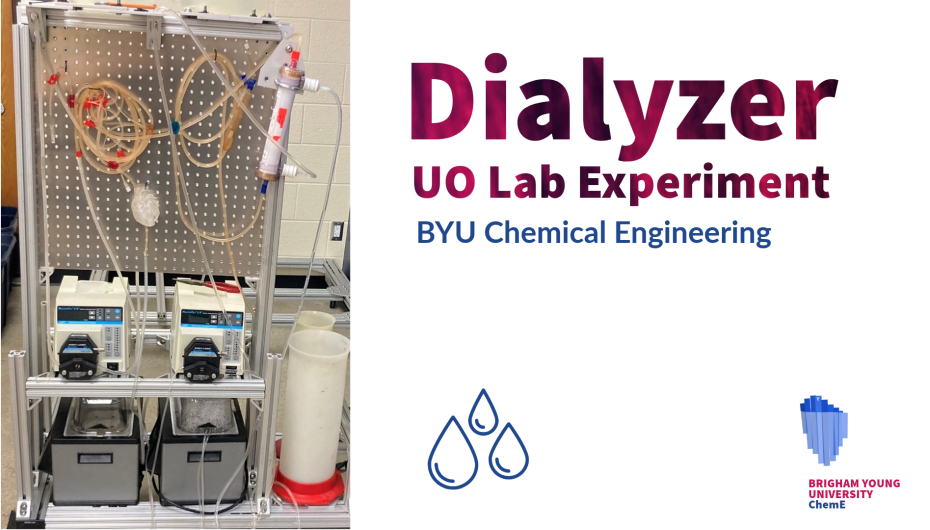Unit Operations Laboratories
Three industrial scenarios are operated in the undergraduate unit operations laboratory (ChEn 479) in the Chemical Engineering Department.

Problem Based Learning Projects
The Problem Based Learning lab requires students to build and operate a fluid flow system with a tank, pump, valves, and piping to achieve a defined objective. Labview is also used together with a labview chasis to program a control system with data collection.
Resources
Introduction - Finned Heat Exchanger
NI Data Collection and Control
LabJack Data Collection and Control
Resources for the Problem Based Learning Projects
- Job Hazards Analysis (JHA) Template
- Plate Heat Exchanger Details
- Previous Labview Manual
- Intro vi for the Finned Exchanger Activity
- PID Control Example
- Xylem Standard Xchange SSCF Design Data
- Electromagnetic Flow Meter Manual
- Electromagnetic Flow Meter Calibration
- Prosense Flow Meter Manual
- Veris Pressure Transducer Manual
- Download Pump Performance Curves
- LabJack Items
As an introduction to the Problem Based Learning Lab, an example with a finned heat exchanger is given where you'll review the below 5 videos after which you'll complete the tasks outlined in Learning Suite.
overrideBackgroundColorOrImage=
overrideTextColor=
promoTextAlignment=
overrideCardHideSection=
overrideCardHideByline=
overrideCardHideDescription=
overridebuttonBgColor=
overrideButtonText=
promoTextAlignment=
overrideBackgroundColorOrImage=
overrideTextColor=
promoTextAlignment=
overrideCardHideSection=
overrideCardHideByline=
overrideCardHideDescription=
overridebuttonBgColor=
overrideButtonText=
promoTextAlignment=
overrideBackgroundColorOrImage=
overrideTextColor=
promoTextAlignment=
overrideCardHideSection=
overrideCardHideByline=
overrideCardHideDescription=
overridebuttonBgColor=
overrideButtonText=
promoTextAlignment=
overrideBackgroundColorOrImage=
overrideTextColor=
promoTextAlignment=
overrideCardHideSection=
overrideCardHideByline=
overrideCardHideDescription=
overridebuttonBgColor=
overrideButtonText=
promoTextAlignment=
overrideBackgroundColorOrImage=
overrideTextColor=
promoTextAlignment=
overrideCardHideSection=
overrideCardHideByline=
overrideCardHideDescription=
overridebuttonBgColor=
overrideButtonText=
promoTextAlignment=
overrideBackgroundColorOrImage=
overrideTextColor=
promoTextAlignment=
overrideCardHideSection=
overrideCardHideByline=
overrideCardHideDescription=
overridebuttonBgColor=
overrideButtonText=
promoTextAlignment=
Introductory Videos for Data Collection and Control with National Instruments (Labview)
Introductory Videos for Data Collection and Control with LabJack U3
BioFlo 110 Bioreactor and System
Multiple laboratory activities with the three (3) New Brunswick Scientific bioreactors requires students to assemble, calibrate, operate and analyze the reactor system to achieve a defined objective. Data collection is completed with an ESP32 microcontroller.
Read Full Story
Resources
Operational Videos
Data Collection
overrideBackgroundColorOrImage=
overrideTextColor=
promoTextAlignment=
overrideCardHideSection=
overrideCardHideByline=
overrideCardHideDescription=
overridebuttonBgColor=
overrideButtonText=
promoTextAlignment=
overrideBackgroundColorOrImage=
overrideTextColor=
promoTextAlignment=
overrideCardHideSection=
overrideCardHideByline=
overrideCardHideDescription=
overridebuttonBgColor=
overrideButtonText=
promoTextAlignment=
overrideBackgroundColorOrImage=
overrideTextColor=
promoTextAlignment=
overrideCardHideSection=
overrideCardHideByline=
overrideCardHideDescription=
overridebuttonBgColor=
overrideButtonText=
promoTextAlignment=
overrideBackgroundColorOrImage=
overrideTextColor=
promoTextAlignment=
overrideCardHideSection=
overrideCardHideByline=
overrideCardHideDescription=
overridebuttonBgColor=
overrideButtonText=
promoTextAlignment=
overrideBackgroundColorOrImage=
overrideTextColor=
promoTextAlignment=
overrideCardHideSection=
overrideCardHideByline=
overrideCardHideDescription=
overridebuttonBgColor=
overrideButtonText=
promoTextAlignment=
overrideBackgroundColorOrImage=
overrideTextColor=
promoTextAlignment=
overrideCardHideSection=
overrideCardHideByline=
overrideCardHideDescription=
overridebuttonBgColor=
overrideButtonText=
promoTextAlignment=
data-content-type="video"
overrideBackgroundColorOrImage=
overrideTextColor=
promoTextAlignment=
overrideCardHideSection=
overrideCardHideByline=
overrideCardHideDescription=
overridebuttonBgColor=
overrideButtonText=
promoTextAlignment=

Shell and Tube Heat Exchanger System
Two of the three shell and tube heat exchanger systems are pictured above. They each consist of a tank, pump, and heat exchanger. The flow though the tube side is measured and controlled and the steam pressure is also measured and controlled. Other variables are also controlled and measured via a Labview interfaced with a National Instruments cRIO-9074 interface. The third setup can be used for thermally treating milk. It has an additional plate exchanger to also cool the milk after heating. There are other slight modifications to facilitate offloading the product and for cleaning.
Resources
Run S&T #1
Run S&T #2
Run S&T #3
Resources for the Shell and Tube Heat Exchanger System
Run the Shell and Tube Heat Exchanger System #1!
In order to run the experiment, you need to be onsite at BYU in the Clyde Building room CB217A. There you will log onto a CAEDM computer and use the Pale Moon browser to go to the following link:
- Ensure that you fully understand how to operate the equipment safely.
- Request control by right clicking on the graphical user interface (gui) after clicking on the above link in the Pale Moon browser.
- Remember to not run the pump without sufficient water in the tank. Also, please do not open the manual steam valve without water flowing through the system.
- Turn off the steam valve manually before stopping fluid flow. Then verify the fluid temperature is less than 50 C before ceasing fluid flow.
- Release control by right clicking on the graphical user interface after safely shutting down the equipment.
Run the Shell and Tube Heat Exchanger System #2!
In order to run the experiment, you need to be onsite at BYU in the Clyde Building room CB217A. There you will log onto a CAEDM computer and use the Pale Moon browser to go to the following link:
- Ensure that you fully understand how to operate the equipment safely.
- Request control by right clicking on the graphical user interface (gui) after clicking on the above link in the Pale Moon browser.
- Remember to not run the pump without sufficient water in the tank. Also, please do not open the manual steam valve without water flowing through the system.
- Turn off the steam valve manually before stopping fluid flow. Then verify the fluid temperature is less than 50 C before ceasing fluid flow.
- Release control by right clicking on the graphical user interface after safely shutting down the equipment.
Run the Shell and Tube Heat Exchanger System #3!
In order to run the experiment, you need to be onsite at BYU in the Clyde Building room CB217A. There you will log onto a CAEDM computer and use the Pale Moon browser to go to the following link:
- Ensure that you fully understand how to operate the equipment safely.
- Request control by right clicking on the graphical user interface (gui) after clicking on the above link in the Pale Moon browser.
- Remember to not run the pump without sufficient water in the tank. Also, please do not open the manual steam valve without water flowing through the system.
- Turn off the steam valve manually before stopping fluid flow. Then verify the fluid temperature is less than 50 C before ceasing fluid flow.
- Release control by right clicking on the graphical user interface after safely shutting down the equipment.

Catalytic Methanation System
The catalytic methanation experiment consists of a catalytic reactor, a gas analyzer, and three gases (carbon dioxide, hydrogen and helium). The flow of those gases is controlled as is the reactor temperature. Control is by custom Labview software using a National Instruments cRIO-9074 chasis.
Resources
Run Methanation #1
Run Methanation #2
Videos
overrideBackgroundColorOrImage=
overrideTextColor=
promoTextAlignment=
overrideCardHideSection=
overrideCardHideByline=
overrideCardHideDescription=
overridebuttonBgColor=
overrideButtonText=
promoTextAlignment=
overrideBackgroundColorOrImage=
overrideTextColor=
promoTextAlignment=
overrideCardHideSection=
overrideCardHideByline=
overrideCardHideDescription=
overridebuttonBgColor=
overrideButtonText=
promoTextAlignment=
Resources for the Catalytic Methanation System
- Operating Procedures
- Job Hazards Analysis (JHA) Template
- Process and Instrumentation Diagram
- Bartholomew Paper
- GC Brief Background
- Download GC Calibration Data
- Download Equipment List
- Download Example Data
- Images of Component Equipment Parts
Run the Catalytic Methanation System #1!
In order to run the experiment, you need to be onsite at BYU in the Clyde Building room CB217A. There you will log onto a CAEDM computer and use the Pale Moon browser to go to the following link:
- Ensure that you fully understand how to operate the equipment safely.
- Request control by right clicking on the graphical user interface (gui) after clicking on the above link in the Pale Moon browser.
- Remember to not turn on the heater without 200 sccm of gas flowing through the reactor.
- Release control by right clicking on the graphical user interface after safely and responsibly shutting down the equipment.
Run the Catalytic Methanation System #2!
In order to run the experiment, you need to be onsite at BYU in the Clyde Building room CB217A. There you will log onto a CAEDM computer and use the Pale Moon browser to go to the following link:
- Ensure that you fully understand how to operate the equipment safely.
- Request control by right clicking on the graphical user interface (gui) after clicking on the above link in the Pale Moon browser.
- Remember to not turn on the heater without 200 sccm of gas flowing through the reactor.
- Release control by right clicking on the graphical user interface after safely and responsibly shutting down the equipment.

Dialyzer Setup
The dialyzer experiment requires students to heat a liquid sample with urea present and exchange that solution with a dialyzate to remove the urea from the solution (blood representative). Actual dialyzers used in dialysis operations are connected per the students designs to optimize the process and evaluate the mass transfer coefficient.
Resources
Videos
Videos TBA
Further Resources
- Technical Writing
- Statistical/Data Analysis
- General Statistics Presentation
- Stats for Engineering Presentation
- Regression Statistics Lecture (Dr. Knotts)
- Regression Statistics Write-up (Dr. Knotts)
- Experimental Design Procedure
- Practical Statistics (Dr. Baxter)
- Linear Analysis VBA Tool (Dr. Baxter)
- Confidence Invervals vs Prediction Bands
- Excel Linear Regression with Statistical Measures (Dr. Knotts)
- MatchCad Polynomial Example (Dr. Knotts)
- MathCad Monte Carlo Example (Dr. Knotts)
- Lab Ambient Conditions
- Safety Data Sheets
- Permission to Start




























